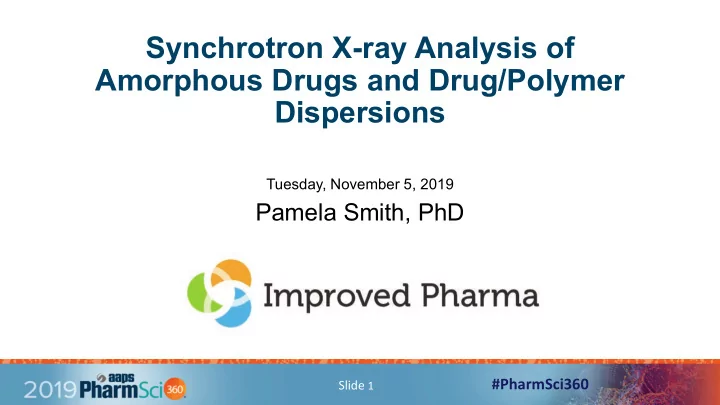

Synchrotron X-ray Analysis of Amorphous Drugs and Drug/Polymer Dispersions Tuesday, November 5, 2019 Pamela Smith, PhD #PharmSci360 Slide 1
Session Description and Objectives • Synchrotron X-ray Pair Distribution • What is PDF? Function (SXPDF) techniques • Why is a synchrotron needed? provide valuable information about • Domains of drug molecules in a amorphous materials and dispersion dispersions. • Stability • Latest advances #PharmSci360 Slide 2
Biography and Contact Information • Contact information: • At the show: booth 551 • After the show: pam.smith@improvedpharma.com #PharmSci360 Slide 3
XRD vs. PDF … global view vs. local view XRD (Bragg diffraction) PDF (atomic pair distribution function) • Average structure, or global view • Fourier transform of XRD of the structure • Yields local structure, environment of • Peaks in the pattern represent the atom periodic occurrences of an atomic • How many neighbors are there and plane in a crystal how far away are they? • There is also information between and underneath the Bragg peaks • Determines the distribution of distances between pairs of atoms • We can extract this additional information by mathematical methods and the right experimental techniques #PharmSci360 Slide 4
Distribution Functions First σ Coordination shell Second Coordination shell g(r) Flaw of Averages 1.0 PDF measures the AVERAGE structure σ 2 σ 3 σ i.e. coordination number 0 #PharmSci360 Slide 5
Different Types of Interactions: Total = Intra + Inter Intramolecular PDF: Distances between atoms within a molecule Intermolecular PDF: NN NNNN Distances between atoms of neighboring NNN molecules #PharmSci360 Slide 6
Synchrotron XRPD is required Q max affects SNR and resolution keV 114.76 • Data quality at large Q-values reflects the importance of 61.62 using a high-energy X-ray 17 beam 19.6 • More Q-space provides more data for the Fourier transform; leads to better quality data Germanium Dioxide • If Q max is too low, resolution suffers #PharmSci360 Slide 7
PDF of Drug/Polymer Dispersion • Industry need • Amorphous forms have better solubility, but can be difficult to keep amorphous • Drug/polymer dispersions are one solution • How to know which dispersions will successfully inhibit crystallization? • PDF • API molecules in close contact with each other increase the likelihood of crystallization • Can differentiate PDF of drug from PDF of polymer • PDF can determine if API domains exist • Lack of API domains are desired #PharmSci360 Slide 8
Lapatinib Drug/Polymer Dispersion Study Comparison of measurement X-ray factors Pure polymer 1:3 API/Polymer 1:1 API/Polymer 3:1 API/Polymer Pure amorphous API Pure crystalline API • Residual crystallinity of lapatinib can be seen in several samples, including the “pure” amorphous API #PharmSci360 Slide 9
Lapatinib Drug/Polymer Dispersion Study Total PDF curves and intra/inter PDF curves • Separate the total PDF curve into separate components • Subtract components to reveal differences #PharmSci360 Slide 10
Lapatinib Drug/Polymer Dispersion Study Differential PDF curves HPMCP dispersions HPMC-E3 dispersions • The only dispersion lacking intermolecular API interactions (no NN API domains) • The only dispersion that remained amorphous after stress testing at 40 ˚ C/75% RH #PharmSci360 Slide 11
Latest Advances Collaboration with Materials Development Inc. through Phase 2 SBIR • Lab on a drop with acoustic levitation • Lab model for spray drying • Suspend a droplet in the sample beam and obtain patterns as the drop evaporates, leaving amorphous material behind • Vitrification by container-less melting • Obtain hard-to-get amorphous materials • Drug/polymer dispersion screen • Quickly screen several different formulations on an extremely small scale #PharmSci360 Slide 12
References • Egami, T. and Billinge, S. J. L. 2003. Underneath the Bragg peaks: Structural Analysis of Complex Materials. Pergamon Press, Elsevier Ltd. New York • Benchmark oxygen-oxygen pair-distribution function of ambient water from x-ray diffraction measurements with a wide Q-range , L.B. Skinner, C. Huang, D. Schlesinger, L.G.M. Pettersson, A. Nilsson, C.J. Benmore. J. Chem. Phys. 138 , 074506 (2013). • Local Structure of Drug Interactions in Amorphous Solid Dispersions characterized by Synchrotron X-Ray diffraction and Pair Distribution Function Analysis. G. Lima Barros de Araujo, C.J. Benmore and S.R. Byrn, Scientific Reports 7 (2017) 46367. #PharmSci360 Slide 13
Acknowledgments • Stephen R. Byrn, Improved Pharma • Gabriel L.B. de Araujo, Department of Pharmacy, University of Sao Paulo • Chris J. Benmore, X-ray Science Division, Advanced Photon Source, Argonne National Laboratory #PharmSci360 Slide 14
Questions Pamela A. Smith Stephen R. Byrn Booth Number 551 Booth Number 551 pam.smith@improvedpharma.com steve.byrn@improvedpharma.com www.improvedpharma.com www.improvedpharma.com #PharmSci360 Slide 15
Recommend
More recommend